Desde 1980, la litotricia extracorpórea por ondas de choque (SWL) ha sido empleada en el tratamiento de las litiasis urinarias, ofreciendo alternativas no invasivas a las técnicas quirúrgicas. Aunque limitada por tamaño y ubicación de las piedras, su efectividad se ve afectada por varios factores. A pesar de la evolución de técnicas quirúrgicas, la SWL podría mantener su relevancia con nuevos avances. Nuestro objetivo es revisar la bibliografía existente para recopilar los mayores avances hasta la fecha en el tratamiento extracorpóreo de la litiasis.
Material y métodosSe ha realizado una revisión bibliográfica no sistemática, entre los años 2017 a 2023 para obtener 26 artículos sobre 3 tipos de innovación tecnológica en litotricia extracorpórea: Burst Wave Lithotripsy (BWL), Histotripsy y Microbubble Lithotripsy (ML).
ResultadosLa BWL emplea ondas sinusoidales ultrasónicas de menor y mayor frecuencia que la SWL tradicional. Su mecanismo de acción genera una fragmentación de mayor calidad (finos fragmentos) en lugar de generar fuerzas tensionales como en la SWL tradicional que generan líneas de fractura que dan lugar a fragmentos de mayor tamaño. Resultados en cerdos y humanos han mostrado fragmentación efectiva con buen perfil de seguridad. Basada en la tecnología de ultrasonido focalizado de alta intensidad (HIFU), la histotricia fragmenta tejido empleando fenómenos de cavitación. Han mostrado buenos resultados in vitro, aunque la formación de microburbujas que se interponen entre la litiasis y las ondas de ultrasonido son un impedimento para el progreso de esta técnica. La ML combina microburbujas y ultrasonido para fragmentar litiasis con seguridad y eficacia. Resultados in vitro y en cerdos son prometedores. Puede optimizar tratamientos y reducir niveles energéticos.
ConclusionesLa innovación tecnológica no solo se está aplicando a técnicas endourológicas, sino también a la ESWL. Nuevas técnicas como BWL, histotricia y ML son prometedoras, con buenos resultados en fase de investigación.
Since 1980, extracorporeal Shock Wave Lithotripsy (SWL) has been employed in the treatment of urolithiasis, offering noninvasive alternatives to surgical techniques. In addition to being limited by the size and location of the stones, its efficacy is influenced by several factors. Despite the advancement of other surgical techniques, SWL could maintain its position with new improvements. Our objective is to review the existing literature on the latest advances in the extracorporeal treatment of lithiasis.
Material and methodsA non-systematic literature review was carried out from 2017 to 2023 to obtain 26 articles on three different emerging technologies in extracorporeal lithotripsy: Burst Wave Lithotripsy (BWL), Histotripsy, and Microbubble Lithotripsy (ML).
ResultsThe BWL uses sinusoidal bursts of US waves delivered at lower and higher frequencies than conventional SWL. Its mechanism of action generates a higher quality fragmentation (fine fragments) instead of generating tensile stresses for stone fracture resulting in larger fragments, as in traditional SWL. Studies in pigs and humans have shown effective fragmentation with a good safety profile. Based on High Intensity Focused Ultrasound (HIFU) technology, histotripsy fragments tissue through cavitation. Good in vitro results have been shown, but the formation of microbubbles between the stone and ultrasound waves hinders the progress of this technique. Microbubble Lithotripsy (ML) combines microbubbles and ultrasound for safe and effective stone fragmentation. In vitro and pig results are promising. This technique can help optimize treatments and reduce energy levels.
ConclusionsTechnological innovation is not only being applied to endourological techniques, but also to ESWL. New techniques such as BWL, histotripsy and ML are promising, with good results in the research phase.
Artículo
Comprando el artículo el PDF del mismo podrá ser descargado
Precio 19,34 €
Comprar ahora










